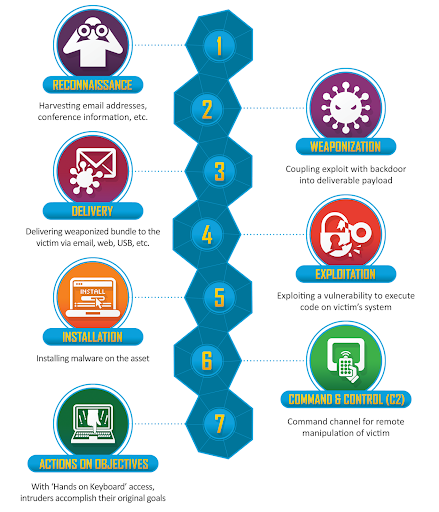Navigating our digital spaces feels increasingly overwhelming, even for the most tech-savvy users. Cyber attacks are escalating in sophistication, with hackers honing their capacity to carry out complex, multifaceted operations. And no one is safe. Cybercrime affects us all individually, like the Ontario student who recently lost $3000 in a phishing scam, or more widescale, like the recent 23andMe credential stuffing attack.
Fortunately, it’s possible to disrupt these attacks before the hackers achieve their objectives. How? By understanding the various stages of the attack chain! When creating their cybersecurity strategies, organizations can use the “Cyber Kill Chain” to prepare, detect, and respond to cyber threats.
In this article, you will learn more about the attack chain and each stage of a cyber attack to gain the necessary insights to disrupt a threat and defend your data. We’ll also discuss the importance of fostering a solid cybersecurity culture at your organization so that your community knows how to take action to prevent a data breach.
The Genesis of the Attack Chain
In 2011, Lockheed Martin created the “Cyber Kill Chain,” a cybersecurity approach that has become a staple in the industry. They adapted the concept from the military principle, which refers to a systematic sequence of steps for identifying and thwarting an adversary’s objectives.
Regarding cybersecurity, the Cyber Kill Chain offers a model for identifying a hacker’s tactics so that you can intercept them before they wreak significant damage. The renowned aerospace company’s framework also gives organizations a structure for understanding and addressing online threats.
Lockheed Martin created this model to help businesses address advanced persistent threats (APTS): a targeted and coordinated cyberattack where an unauthorized individual or group uses advanced methods like social engineering to gain access to an organization’s IT infrastructure and fly under the radar for an extended period.
By understanding how all stages work individually and together, you can develop tailored cybersecurity approaches for each step to holistically minimize the threat from all angles. You can also train your staff to contain the incident, giving them the skills to break the attack chain at each stage, depending on when they discover it.
By employing the Cyber Kill Chain, businesses can rely on a proactive defense approach that increases their resilience. They can address their vulnerabilities and weaknesses, mitigate risk, and reduce the likelihood of a successful breach.
Breaking Down the Attack Chain
Lockheed Martin’s “Cyber Kill Chain” framework proposes that the attack chain has seven distinct steps, each offering a unique opportunity for an organization to step in and nip the threat in the bud.

*Photo courtesy of Lockheed Martin, the Cyber Kill Chain® framework
1. Reconnaissance
Observation is the first step to carrying out an attack. Typically, the reconnaissance stage involves gathering information and assessing a potential target. The hackers will work to understand the organization’s infrastructure and overall workplace ecosystem and seek to identify potential vulnerabilities.
2. Weaponization
The information gathered during the reconnaissance stage allows the attacker to move on to the next step: developing customized and effective tactics to breach their target’s systems and achieve their goals.
They will create malicious payloads tailored to the target’s vulnerabilities, developing code or software that can either gain unauthorized access, steal data, or damage a system’s ability to work correctly. By aligning their payloads with the weaknesses in their target, it makes it more likely that they’ll succeed.
3. Delivery
After a hacker gathers their information and creates their strategy, it’s time to take action and launch their attack. They will deliver their malicious code or software into the target system’s IT infrastructure using phishing emails, a USB drive, or an infected website.
4. Exploitation
Once they deliver their payload, the attackers will leverage the target’s vulnerabilities, like a weak password or a misconfigured setting, to execute the malicious code or software – either remotely or locally, depending on their tactic.
5. Installation
After the hackers have successfully breached and compromised their target’s system, they need to take steps to maintain undetected access. They will create some sort of back door or install malware that allows them to continue to gain access even if the organization discovers and closes their original entrance.
6. Command and Control
After the hackers create this back door, they create a command and control channel to continue taking action on the target’s network from a remote location undetected for as long as they need.
This attack chain step maintains control over their operations because, with it, hackers can do whatever they want and achieve their nefarious goals.
7. Actions on Objectives
Once they control your system, the hackers may steal confidential and intellectual property data. They can also move within the network and execute new attacks to create additional entry points – expanding their potential damage. In other cases, they may cause interruptions in your operations or destroy some of your digital property.
Their goals will depend on their motives: do they want to profit from your business? Or are they more interested in espionage or sabotage? Our recent blog article dives deeper into the question, “What do hackers do with stolen data?”
Disrupting the Attack Chain
By understanding the actions of a hacker at each stage of their attack, your business can develop sound strategies to counteract them. In fact, during the entire attack chain, organizations can find many opportunities to rapidly detect, mitigate, and disrupt the threat before it moves forward to cause harm. Of course, hackers have sophisticated tactics that can evade our best defenses, so a layered approach is vital to creating multiple fences that protect our critical data.
For example, ensuring your organization regularly conducts security patches can eliminate vulnerabilities. These vulnerabilities might be discovered during the attacker’s reconnaissance phase or leveraged during exploitation.
Additionally, businesses should implement advanced endpoint detection and response solutions that leverage artificial intelligence to spot unusual activity on your network and block any malware deployment. This can help stop a threat during the delivery and exploitation, installation, and command/control phases. DNS filtering and threat protection software can also help detect malicious links and attachments before a phishing attempt swindles a user from your organization.
An attacker may successfully infiltrate your network during the delivery and installation phases. However, you can ensure your data remains useless to them by implementing tactics like network segmentation, data masking, encryption, passwordless and biometric authentication, and other Zero Trust cybersecurity strategies.
Beyond implementing technology solutions, educating your users on how their behaviour can thwart an attack is the most crucial step to data protection. The Ontario government knows this. They recently launched an initiative to educate K-12 students on cybersecurity to start a culture of cybersecurity awareness at a young age.
Employees can learn how to avoid social engineering attempts by prioritizing user awareness training. They will act as the first line of defense, with the knowledge to make better decisions to avoid creating entry points for bad actors to deliver their malicious payloads. This way, the attack chain never gets beyond the delivery phase.
Partner with PC Corp to Tackle the Attack Chain
If your organization wants to proactively take action to address your cybersecurity and protect your data, it’s fundamental to understand every stage of the attack chain.
This knowledge will help you detect threats early and respond swiftly before significant damage occurs. Most importantly, this understanding will help you continuously improve your strategy, allowing you to drill down on the cause of a cyber incident if one does occur and adapt your measures to prevent future attacks.
With cyber threats constantly evolving, businesses will only thrive if they prioritize learning as a regular and consistent commitment. At PC Corp, we offer comprehensive Managed IT services that work to enhance your productivity and cybersecurity through stronger data protection. Our experts can help you implement the technological solutions and user awareness training you need to handle every stage of the attack chain.
Connect with us to discuss how PC Corp can partner with your organization to keep your operations running as smoothly and securely as possible.

